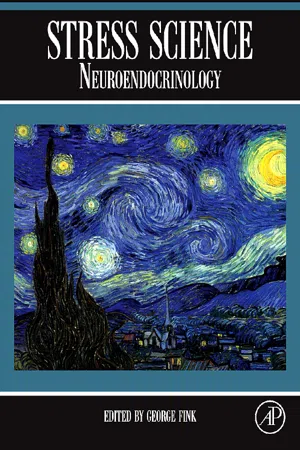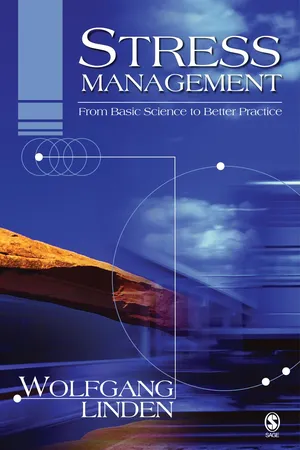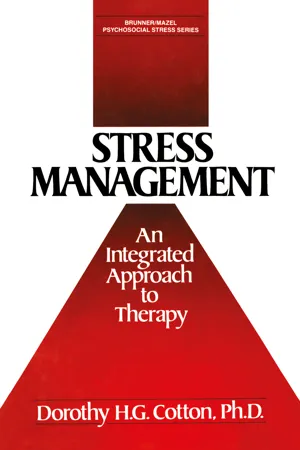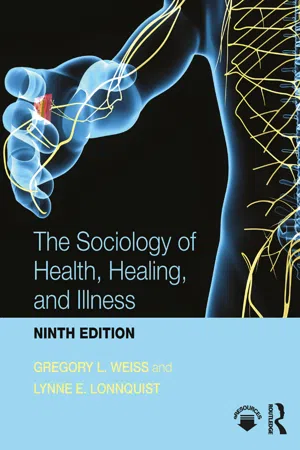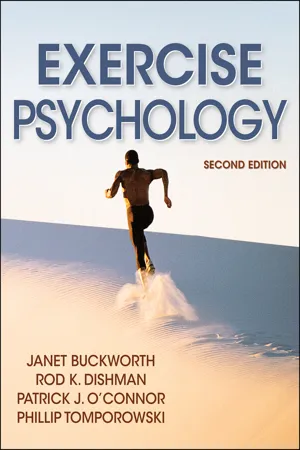Psychology
Stress Definition
Stress is a physiological and psychological response to a perceived threat or challenge. It can be triggered by various factors, such as environmental pressures, personal expectations, or life changes. Stress can manifest as physical, emotional, or behavioral symptoms and may have both short-term and long-term effects on an individual's well-being.
Written by Perlego with AI-assistance
Related key terms
Related key terms
1 of 4
Related key terms
1 of 3
12 Key excerpts on "Stress Definition"
- eBook - ePub
- Gregory Weiss, Denise Copelton(Authors)
- 2023(Publication Date)
- Routledge(Publisher)
This chapter presents a brief description of the historical development of the concept, an introduction to the various ways stress is conceptualized, and a model of social stress that attempts to capture its causes, mediating effects, and outcomes. Current research into stress as it is related to social class, race, sexual orientation, and gender is also presented.Definition of Stress
The term “stress” is used in countless ways. It can refer to events or circumstances (e.g., a test) that cause unease, to the general unease we feel during such events, to the specific bodily responses to such events (e.g., rapid heartbeat), or to the mind’s and body’s attempts to deal with the unease in order to recapture a sense of wellness.Most researchers include in the concept of stress some reference to the resulting state in an individual who has experienced various demands. Stoklos (1986 :35) defines stress as “a state of imbalance within a person, elicited by an actual or perceived disparity between environmental demands and the person’s capacity to cope with these demands.” Stress occurs in response to “strainful and threatening circumstances in the environment” and has clearer boundaries than states such as anxiety or depression, which are more global, more diffuse, and may exist “even in the absence of specific threats” (Pearlin and Schooler 1978 :4).Historical Development of the Stress Concept
The idea of stress has existed for centuries. As discussed in Chapter 2 - eBook - ePub
Stress Science
Neuroendocrinology
- George Fink(Author)
- 2010(Publication Date)
- Academic Press(Publisher)
There has been much controversy and debate about Selye’s concepts and particularly Selye’s view that stress is best regarded as a nonspecific response. Because of their heuristic value, these points will be further considered later.Other definitions, reviewed in detail by Selye in his treatise Stress in Health and Disease , include the following:1. In behavioral sciences, stress is regarded as the “perception of threat, with resulting anxiety discomfort, emotional tension, and difficulty in adjustment.”2. In the group situation, lack of structure or loss of anchor “makes it difficult or impossible for the group to cope with the requirements of the situation, and the problem of leadership and interpersonal behavior becomes one of evolving or supplying a structure or anchor and of supplying the expertness for coping with the demands of the situation.”3. Stress can also be defined in terms of pure neuro-endocrinology. Eugene Yates, for example, defined stress as any stimulus that will provoke the release of ACTH and adrenal glucocorticoids. Presumably, the same might apply to the equally powerful sympathetic markers of stress, underscored earlier by Walter Cannon.4. Finally, Selye also mentions Richard Lazarus, famous for his work in cognitive psychology and focus on the emotions. Lazarus underscores the difficulties of reaching a precise overarching definition of stress by setting out the following different meanings of the term: “In spite of consistent confusion about the precise meaning of the term, stress is widely recognized as a central problem in human life. Scientists of many disciplines have conceptualized stress but each field appears to have something different in mind concerning its meaning. For the sociologist, it is social disequilibrium, that is, disturbances in the social structure within which people live. Engineers conceive of stress as some external force which produces strain in the materials exposed to it. Physiologists deal with the physical stressors that include a wide range of stimulus conditions that are noxious to the body. In the history of psychological stress research, there has been no clear separation between physical stressors which attack biological tissue systems and psychological stressors which produce their effects purely because of their psychological significance.” - eBook - ePub
Stress Management
From Basic Science to Better Practice
- Wolfgang Linden(Author)
- 2004(Publication Date)
- SAGE Publications, Inc(Publisher)
stressor to refer to a causative agent, a trigger for this process.A two-step sequence of “stress” is also reflected in definitions found in psychological textbooks. Girdano, Everly, and Dusek (1993, p. 7) state, “Stress is the body reacting. It is psychophysiological (mind-body) arousal that can fatigue body systems to the point of malfunction and disease.” Hence, popular and scientific definitions see “stress” as a process in which external and internal stimuli, forces, or systems interact, where triggers activate a response system that may lead to exhaustion and vulnerability (Wheaton, 1996).My definition of stress, as applied to stress management, is this:Stress is a mediational process in which stressors (or demands) trigger an attempt at adaptation or resolution that results in individual distress if the organism is unsuccessful in satisfying the demand. Stress responding occurs at physiological, behavioral, and cognitive levels. Stress is more than just acute subjective or physiological activation and has its potentially most deleterious health effects when it becomes chronic.Before delving further into the history and basic research on the stress concept, it should be clarified that, consistent with my definition of stress, the emphasis is going to be on chronic stress and its health consequences rather than on a singular, traumatic kind of stress exposure. Exposure to a traumatic event, like witnessing or being subjected to violence, is a profound event with potentially grave and long-lasting psychological sequelae; in their most severe form, these sequelae qualify for posttraumatic stress disorder, which can be quite debilitating. Little is known about the long-term physical health consequences of traumatic stress (with the exception of early life exposure to trauma, discussed below) and the treatment techniques embraced by stress management (Ong, Linden, & Young, 2004) are not treatments of choice for posttraumatic stress disorder (Taylor, Lerner, Sherman, Sage, & McDowell, 2003). - eBook - ePub
- Jeremy Stranks(Author)
- 2007(Publication Date)
- Routledge(Publisher)
According to the TUC, stress occurs where demands made on individuals do not match the resources available or meet the individual’s needs and motivation. Stress will arise if the workload is too large for the number of workers and time available. Equally, a boring or repetitive task which does not use the potential skills and experience of some individuals will cause them stress.The HSE (1995) defined work stress as ‘pressure and extreme demands placed on a person beyond his ability to cope’. In 1999, the HSC stated that ‘stress is the reaction that people have to excessive pressures or other types of demand placed upon them’.According to Cox (1993) , ‘stress is now understood as a psychological state that results from people’s perceptions of an imbalance between job demands and their abilities to cope with those demands’.A further definition is ‘work stress is a psychological state which can cause an individual to behave dysfunctionally at work and results from people’s response to an imbalance between job demands and their abilities to cope’.Fundamentally, workplace stress arises when people try to cope with tasks, responsibilities or other forms of pressure connected with their jobs, but encounter difficulty, strain, anxiety and worry in endeavouring to cope.Defining stress
A consideration of the above definitions of ‘stress’ produces a number of features of stress and the stress response, for example, disturbance of the natural equilibrium, taxation of the body’s resources, failure to cope, sustained anxiety, a non-specific response, pressure and extreme demands and imbalance between job demands and coping ability. Fundamentally, a stressor (or source of stress) produces stress which, in turn, produces a stress response on the part of the individual. No two people respond to the same stressor in the same way or to the same extent. What is important is that, if people are going to cope satisfactorily with the stress in their lives, they must recognize - eBook - ePub
Stress Management
An Integrated Approach to Therapy
- Dorothy H.G. Cotton(Author)
- 2013(Publication Date)
- Routledge(Publisher)
Finally, a definition must provide a direction for therapy. A thorough examination of the key components of the concept “stress” should indicate which areas may need attention in general, as well as pinpoint specific problem areas for the individual client. Thus, although the definition of stress needs to be flexible and broad, it should not be over-inclusive. If it appears to the client that all of his or her actions cause stress, and that all of his or her experiences are a result of stress, then effective intervention may seem overwhelming. The definition must indicate a clear direction to both the therapist and the client.These four characteristics suggest that the concept of stress should be broadly defined, to accommodate a variety of interpretations. However, the specific content and emphasis will vary from one client to another.The issue of definition may be addressed at two levels. First, what are the words or terms that will be used to define the process? Secondly, how is the process described? The former issue is one of semantics; the latter, of empirical knowledge.DEFINING STRESS: THE TERMS
Part of the work of describing stress involves the development of a vocabulary to employ in the description. Although the word “stress” is familiar to almost everyone, it is used in a variety of different ways. “Stress” may refer to a stimulus, to a response, or to a combination of the two. For the sake of clarity, the following definitions will be used in this book:Stressor. Any stimulus which the individual perceives as a threat. Stressors may be physical, psychological, or psychosocial (Asterita, 1985). Physical stressors include such conditions as environmental pollutants, environmental pressures such as extreme changes in temperature, electric shock, prolonged exercise, injuries and other trauma to the body, and exposure to disease.Psychological stressors are those threats which are attributable to the individual's internal reactivity—thoughts, feelings, and concerns about perceived threats. Psychological stressors are somewhat more subjective in that the threat occurs because of the individual's interpretation of an event, rather than as a result of the event itself. - eBook - ePub
Teacher Well-Being
Looking After Yourself and Your Career in the Classroom
- Elizabeth Holmes(Author)
- 2005(Publication Date)
- Routledge(Publisher)
CHAPTER 2 Stress, the good and the badStress: a state of mental or emotional strain or tension resulting from adverse or very demanding circumstances(The New Oxford Dictionary of English)It’s a phrase we hear all the time, in books, in newspapers, on television; even young children talk in terms of ‘being stressed’. Research papers report the damage being done to our ‘social environment’ by insufficient notice being taken of the stress that employees feel, and the devastating impact this can have on the well-being of individuals is apparently stifling creativity and motivation.Stress in the workplace is now at record levels, with the number of days lost as a result of work-related stress, anxiety and depression having doubled since 1995. In fact, it is thought to be the primary reason for taking time off work—above, even, common reasons such as backache and colds. Stress also evidently affects our home life, too, with debt and divorce in particular at record levels.Definitions and perceptions of stress
Perhaps it would be fair to say that stress gets a bad press! But what, exactly, does it mean? Used to describe everything from life-threatening events to situations that merely disrupt our sense of comfort, and a whole array in between, ‘stress’ has meaning for most, if not all, adults and some children. That said, it’s difficult to reach a universally accepted definition. Perhaps it is the fact that we all apply our own meaning to the term that has helped it to become the epidemic of modern life.Regardless of definitions and perceptions, what is widely accepted is that the states of insufficient stress and excessive stress are both to be avoided if our sense of well-being is to be supported. One useful analogy that is often used compares stress with electricity. A certain amount is needed in order for things to work, but too much and you’ll blow them up.EXAMPLE A PERSONAL VIEW OF STRESSStress to me is when I’m scared to write a ‘to do’ list. It’s when my skin breaks out and my hair feels dry. It’s invariably when just about everything goes wrong—car, washing machine, you name it! It’s when I wake up in the night thinking about lesson plans, marking, meetings, conversations I’ve had and conversations I should have had. It’s feeling distracted when I’m not working and exhausted when I am. That’s what stress is to me. - eBook - ePub
- Gregory L. Weiss(Author)
- 2017(Publication Date)
- Routledge(Publisher)
stress as “a state of imbalance within a person, elicited by an actual or perceived disparity between environmental demands and the person’s capacity to cope with these demands.” Stress occurs in response to “strainful and threatening circumstances in the environment” and has clearer boundaries than states such as anxiety or depression, which are more global, more diffuse, and may exist “even in the absence of specific threats” (Pearlin and Schooler, 1978:4).HISTORICAL DEVELOPMENT OF THE STRESS CONCEPT
The idea of stress has existed for centuries. As discussed in Chapter 2 , such historical luminaries as Hippocrates believed in the humoral theory of illness—that positive health results from a mind and body in harmony—and this is perhaps the earliest characterization of an individual who is not “stressed out.” Hippocrates’ belief in the self-healing powers of the body is also consistent with an understanding of the body’s adaptation to stress.Historical records indicate that in the fourteenth century the term was equated with hardship and affliction, and in nineteenth-century medicine, stress was cited as a cause of ill health, as many diseases were attributed by physicians to conditions of “melancholia,” “grief,” or “despair.” Clearly, by the 1800s, there was widespread recognition of the link between mind and body.Ironically, Pasteur’s demonstration that bacteria cause disease (the germ theory of disease) led many physicians and medical researchers to confine their attention to such germ-caused diseases in the hope of finding specific disease etiology and appropriate “magic bullets.” In doing so, many of them abandoned interest in the less concrete areas of attitudes and emotions.Walter Cannon and Hans Selye
Early in the twentieth century, Walter Cannon, an American physiologist, used the term homeostasis - eBook - ePub
Organizational Stress
A Review and Critique of Theory, Research, and Applications
- Cary L. Cooper, Philip J. Dewe, Michael P O'Driscoll(Authors)
- 2001(Publication Date)
- SAGE Publications, Inc(Publisher)
As has already been noted, stress has been defined as a stimulus, a response, or the result of an interaction between the two, with the interaction described in terms of some imbalance between the person and the environment (Cox, 1978). As empirical knowledge has developed, particularly that surrounding the person-environment (P-E) interaction, researchers have considered the nature of that interaction and, more importantly, the psychological processes through which it takes place (Dewe, 1992). From this debate has emerged a belief that traditional approaches to defining stress (i.e., stimulus, response, interaction) have, by directing attention toward external events, diverted researchers away from considering the processes within the individual through which such events are appraised (Duckworth, 1986). This is not to say that such ideas have gone unresearched or that earlier definitional approaches are necessarily inadequate. However, as knowledge and understanding of stimulus, response, and interaction definitions and their associated meaning have advanced, the debate about how stress should be defined has shifted ground. Rather than singling out and focusing separately on the different elements of the stress process, we suggest that it is now time to examine more comprehensively the nature of that process itself and to integrate stimulus and response definitions within an overall conceptual framework that acknowledges the dynamic linkages between all elements of the stress process. Contemporary views on how stress should be defined require researchers to think of stress as being relational (Lazarus & Launier, 1978): the result of a transaction between the individual and the environment (Lazarus, 1990). The transactional approach draws researchers toward identifying those processes that link the individual to the environment - eBook - ePub
- Konstantinos Perrotis, Cary L. Cooper(Authors)
- 2017(Publication Date)
- Routledge(Publisher)
In the beginning it was used mostly in the field of psychosomatic medicine and physics, but it was in 1946 that Hans Selye first mentioned that the ways through which stress affects and is perceived by an individual are unclear and that further examination is needed to fully understand such a popular concept. While at that time period there was no unique definition of stress, the terms ‘stressor’ and ‘strain’ were widely used. ‘Stressor’ referredto the environmental stimulus that could exert pressure on an individual (i.e. working long hours), and ‘strain’ referred to the individual response that could be expressed either physically, psychologically or behaviourally.During the exploration of the stress concept, researchers were mainly focused on three particular approaches:- Stress as the dependent variable (the response): stress is viewed as a response to a stimulus that arises from an upsetting situation or the environment, e.g. work overload or harmful environmental settings. Responses may be physiological or behavioural.
- Stress as the independent variable (the stimulus): stress is viewed as an external phenomenon that acts upon the individual, but without taking into consideration the importance of an individual’s perceptions and past experiences. Stress is considered as a disturbing environmental factor.
- Stress as the intervening variable (the interactionist approach): stress is viewed as the interaction between individuals’ perceptions and their responses towards an external stimulus. In other words, stress refers to the lack of fit that exists between the individual and the environment, and it is the combination of both the stimulus and the response approach (Fisher, 1986).
1. Stress as the dependent variable: response-based definitionsStress can be tracked historically back to the 18th century, where it was used mostly in the field of science and engineering as a concept to describe the force or pressure that was placed upon a material object or person. In such cases, strain was reflected as the resulting distortion on the object/subject under study (Kahn & Byosiere, 1992).In 1935 the Stress Definition was transferred into psychosomatic medicine and biology by Sir Walter Cannon under the ‘fight or flight’ theory. Cannon’s main interest was to investigate the physiological reaction of individuals and animals when they encountered a perceived threat, such as extreme cold or lack of oxygen. Such reactions dictate either a ‘fight or flight’ mode where the organism either stays and confronts the threat or, if the threat is perceived as overwhelming, flees. The easiest way to picture that is to imagine the reactions of a cat when under the perception of threat. When a cat feels threatened it takes a stiff, straight-legged upright stance. At this precise point it decides whether to fight or take flight, with its back legs heading forward (to fight) and its front legs heading backwards (to flight). A pure physiological response to stress! When it comes to humans, this is the most common reaction to a stressful threat. - eBook - ePub
Tales of Agonies
A Psycho-Spiritual Prism
- Emmanuel Abur(Author)
- 2023(Publication Date)
- Austin Macauley Publishers(Publisher)
Of course, normal stress is inevitable in life. In most cases, it is part of our daily routine. Thus, daily traffic jams in busy cities like Lagos and Rome, running to catch up with the bus or train every morning, struggling hard to meet up with assignment deadlines, studying hard to pass a difficult statistics or chemistry exam, eight hours of daily work from Monday to Friday, observing long queues in the bank, hospital, filling station, etc., are everyday stressful experiences we often go through unscathed. Rather than destroy us, they strengthen us and boost our adaptive abilities.On the contrary, nasty experiences of continuous marital conflict, separation or divorce, daily clash with a notorious child who is a drug addict and/or a drunkard, being a victim of repeated sexual assault or physical abuse, a perpetual conflict with the boss at work, experiencing war, violence, kidnapping, or general insecurity, etc., are examples of acute or chronic stress which can break us down.Such is the distressing experience that many people in Nigeria, especially Christians, and in many other parts of the globe are going through, as we saw in the previous chapter. In this chapter, we cursorily present the incidence of stress vis-a-vis the experience of Christians in Nigeria today, and of course, other parts of the world.Understanding Stress
In biomedical sciences, stress is mainly understood as an organism’s response to adverse stimulation. In psychology, it is usually understood as the process where a person and the environment interact, the psychological perception of the danger or pressure associated with that experience, and the bodily response consequent upon the menacing perception.1 From these two conceptions emerge three broad perspectives of stress, namely the response-based perspective, the stimulus-based perspective, and the cognitive-based perspective.The Response-Based Perspective
Hans Selye, the Hungarian Canadian endocrinologist, who carried out important scientific work on the ‘non-specific response of the body to any demand’,2 distinguished between a stressor (the stimulus) and stress (which is the response). A stressor, according to him, “is anything that causes the release of stress hormones.”3The response to the stimulus (the stress), he points out, follows a typical three-stage pattern in humans and animals, called the general adaptation syndrome (GAS). In this pattern, the body initially defends itself against adverse circumstances by activating the sympathetic nervous system, known as the alarm reaction. It mobilizes the body for the fight or flight response, which can be seen phylogenetically as an adaptive short-term reaction to an emergency. - eBook - ePub
Stress at Work
A Sociological Perspective
- Chris Peterson(Author)
- 2018(Publication Date)
- Routledge(Publisher)
CHAPTER 1 Stress as a Psychophysiological ProcessIn this chapter I trace developments in the concept of stress, as a physiological reaction and as a psychophysiological process. This historical review covers presociological inquiries of stress. It examines many of the debates on the meaning of stress, based on early differences in the meaning of the stress response. While these approaches have a number of limitations, an examination shows how early differences in biophysiological and later psychological research contributed an important understanding to the stress response.While earlier, purely physiological approaches provide information about bodily reactions to stress, they do not provide a sufficient understanding of a broad range of processes involved in the stress response. Parallel and more recent psychological research provides some important insights into why different people experience differing amounts of stress from the same stressors. These findings make important contributions to our understanding of the psychophysiological nature of stress.However, psychophysiological approaches fail to account for a broader range of sociocultural factors, a topic addressed in Chapter 2 . Yet these psychophysiological processes do provide an important basis for our understanding of stress, albeit at the individual level of personal experience.While the early biophysiological and psychological researchers have made important contributions, our knowledge about the stress response has recently changed in some important ways. Technological developments in testing procedures and equipment have also produced major changes in our understanding of this response. Yet certain limitations to a thorough understanding of biophysiological and psychological processes remain. We need to employ a critical framework when dealing with various assumptions about the biophysiological aspects of the stress response that require questioning.The chapter covers three issues. The first is a review of the pioneering work of Hans Selye and a critical evaluation of early developments in the stress concept. I then review the influence of psychologically oriented research into the effects of emotional response on physiological reactions and evaluate it for its influence on the stress concept. Finally, I discuss the physiology of the stress response, based on the above approaches. - No longer available |Learn more
- Janet Buckworth, Rod K. Dishman, Patrick J. O'Connor, Phillip D. Tomporowski(Authors)
- 2013(Publication Date)
- Human Kinetics(Publisher)
strain , which is the deformation, distortion, or tension in the object that results from stress.In the life sciences, stress is viewed as an imbalance in physiological systems that activates both physiological and behavioral responses to restore balance. In this way, a stressor is like load, a force that acts on a biological system. Because it is easy to see the analogy between objects resisting or breaking under strain and human tolerance for the burdens of living, it is commonly accepted that stress (imbalance) leads to strain (distortion, tension) in animals as it does in physical objects.Stress is an imbalance in physiological systems that activates physiological and behavioral responses to restore balance. Stressors are the forces that act on a biological system to cause stress.Good and Bad Stress
If chronic stress can increase your risk of conditions such as heart disease, high blood pressure, a suppressed immune system, eating disorders, headaches, sleep disorders, and ulcers, you might be wondering if you should attempt to remove all stress from your life. The answer is no. A certain amount of stress is needed for optimal health and performance—life without stress would be very boring! Stress researcher Hans Selye clearly distinguished between distress (“bad stress”) and eustress (“good stress”). Some level of stress (eustress) is desirable for optimal performance and well-being; however, all of us can reach a point where stress can become too much (distress) and it starts to inhibit our mental, emotional, and physiological abilities to function effectively (see figure 4.1
Index pages curate the most relevant extracts from our library of academic textbooks. They’ve been created using an in-house natural language model (NLM), each adding context and meaning to key research topics.
Explore more topic indexes
Explore more topic indexes
1 of 6
Explore more topic indexes
1 of 4

